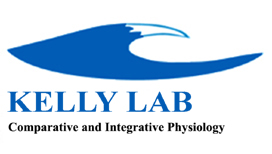

Current research interests and activity in the laboratory concentrate on:
A. The endocrine control of
hydromineral balance
B. The endocrine control of appetite and energy homeostasis.
Our experimental approach integrates several techniques. These include
whole animal physiology and behavior studies, primary cell culture
models for ion transporting epithelia, molecular biology tools as well
as a variety of other methodologies. The research is driven by
imperatives that include environmental considerations, evolutionary
significance and animal health issues (stress reduction).
A. Endocrine control of hydromineral balance: To
maintain hydromineral balance, fish residing in freshwater combat ion
loss and volume loading through the tissue- and cell-specific actions
of ionoregulatory hormones. The endocrine mechanisms of action that
limit diffusive ion loss (e.g. across the gills) and promote active
ion acquisition are still not fully understood. By manipulating
hydromineral status and by using a novel suite of experimental
techniques (e.g. reconstructed in vitro gill models) we are gaining
new insight into the endocrine control of ionoregulatory homeostasis
in teleost fish. Of particular interest are similarities found between
the endocrine control of permeability in lower vertebrate and higher
vertebrate epithelia.
B. Endocrine control of appetite and energy balance:
In mammals, hypothalamic regions responsive to peripheral endocrine
information (e.g. insulin, leptin, gut hormones) exert coordinated
regulation of food intake and metabolism. The mammalian hypothalamus
evidently possesses at least two major groups of neurons that
integrate peripheral information into either orexigenic (neuropeptide
Y [NPY]; agouti-related protein [AgRP]) or anorexogenic signals (a-melanocyte-stimulating
hormone [a-MSH]; cocaine and amphetamine-related transcript [CART])
that respectively stimulate and inhibit appetite. Although in teleosts
many of these neuropeptides (or their homologues) possess similar
properties, central regulation of energy balance is poorly understood,
as are environmental contributions. It is the relationship between
energy balance/appetite and environmental conditions that is
emphasized in this research. A novel example is the recently described
prolactin releasing peptide (PrRP) which has been found to suppress
appetite and release prolactin (an important ionoregulatory hormone in
fish).